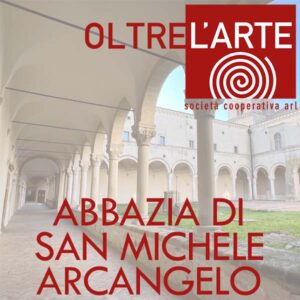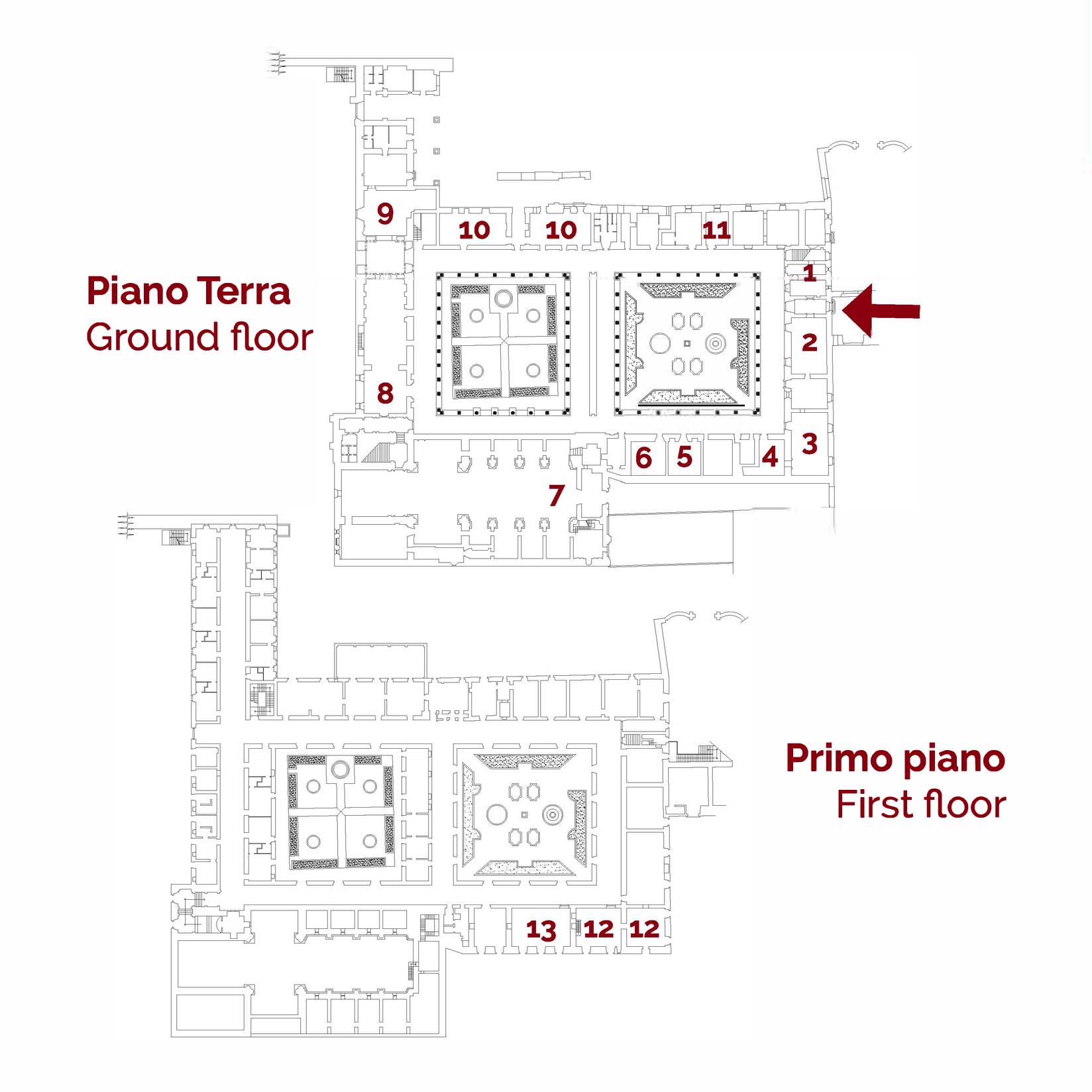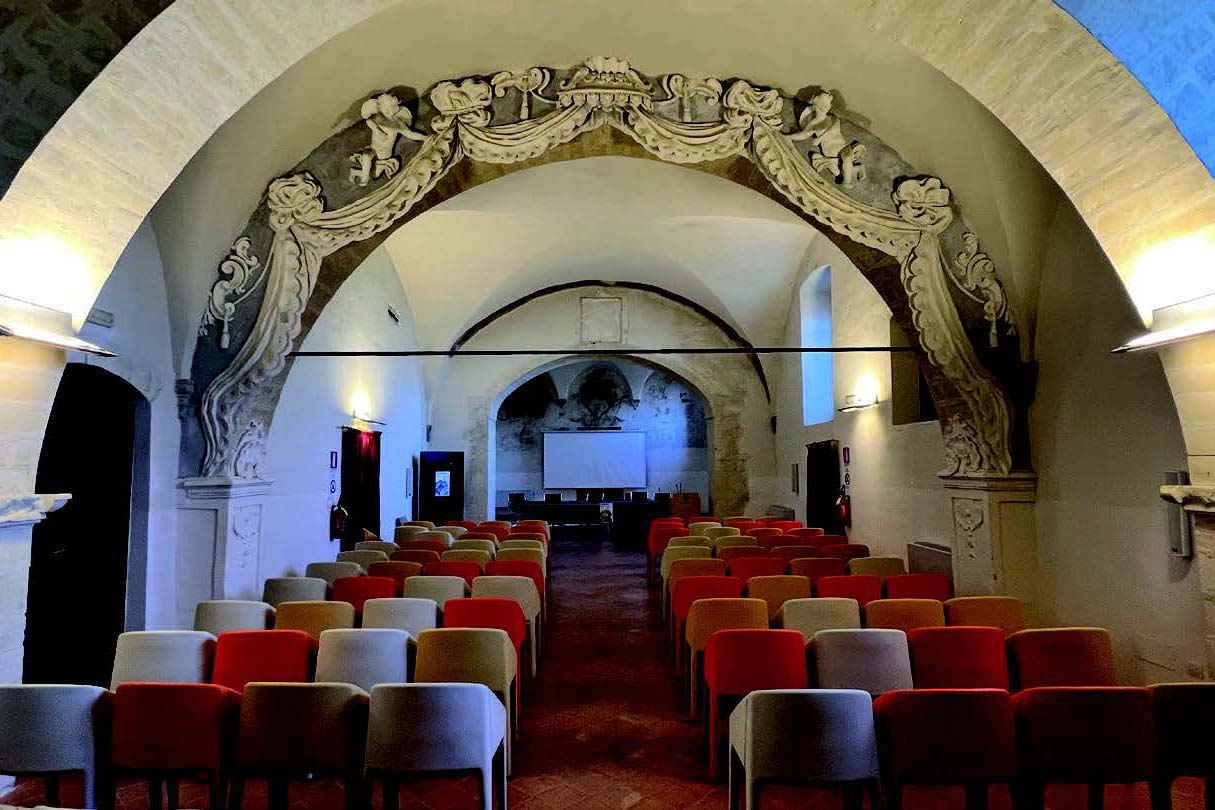
-

“VISITA IN AUTONOMIA” ABBAZIA DI SAN MICHELE ARCANGELO
Scegli Questo prodotto ha più varianti. Le opzioni possono essere scelte nella pagina del prodotto -

“VISITA GUIDATA” ABBAZIA DI SAN MICHELE ARCANGELO
Scegli Questo prodotto ha più varianti. Le opzioni possono essere scelte nella pagina del prodotto
LA STORIA – Abbazia S. Michele Arcangelo
Della fondazione dell’Abbazia dedicata a S. Michele Arcangelo non esistono al momento prove storiche attendibili. La prima fonte scritta su Montescaglioso e sulla presenza benedettina nel suo territorio risale all’anno 893. Si tratta di un’attestazione della proprietà della chiesa di S. Lorenzo da parte dell’Abbazia benedettina di S. Vincenzo al Volturno {Molise), documentata nel 1099 fra le proprietà dell’Abbazia di S. Michele nata probabilmente in questo periodo. Nel corridoio d’ingresso, nella prima sala a sinistra (2) è possibile ammirare un plastico in scala dell’Abbazia; nella sala comunicante (3), invece, ci sono le riproduzioni dello “Scriptorium” e della “Speziaria”. Oltrepassato il corridoio di entrata al complesso monumentale ci si ritrova di fronte al primo chiostro {detto anche occidentale), realizzato tra XV e XVI secolo e destinato allo svolgimento di attività rivolte soprattutto all’esterno: accoglienza degli ospiti, portineria per l’elemosina giornaliera e domenicale destinata ai poveri ecc. Nelle sale del lato nord è possibile visitare la ricostruzione di una tipica cella monastica (4), la sala del “Telamone” (6), una scultura databile tra il lii e di Il secolo a.e .. e un’ampia sala con evidenze archeologiche (5). Il Telamone, di grandi dimensioni e raffigurato completamente nudo, richiama i Sileni e i Satiri dei cortei dionisiaci di età classica
Proseguendo lungo il porticato nord, si giunge al secondo chiostro {detto orientale), più antico del precedente perché realizzato tra Xl e Xli secolo. Nel corso degli scavi effettuati in questo spazio sono emerse le testimonianze di necropoli indigene e del periodo greco, tracce del tessuto urbano {VII-IV sec. a.C.) e testimonianze dell’evoluzione edilizia dell’Abbazia risalenti ad un periodo compreso tra Xl e XVI secolo. Nel chiostro orientale è situato il pozzo con l’articolato sistema di adduzione dell’acqua piovana. Lungo i portici circostanti si articolavano gli spazi funzionali alla vita in comune dei benedettini: la sala del Capitolo (8), la dispensa, la cucina (9) e la spezieria. Ripercorrendo il portico del lato sud è possibile accedere agli ambienti del piano superiore che in origine ospitavano l’appartamento dell’Abate (12), l’archivio e la biblioteca (13), completamente affrescata nella fascia perimetrale alta. Il ciclo di affreschi, risalente alla prima metà del ‘600, raffigura una serie di Santi, benedettini e non, e personalità del mondo classico come Pitagora e Arpocrate. Stando all’ipotesi dello studioso Sigfrido Hobel, al momento non sufficientemente suffragata, il simbolismo dei dipinti sarebbe riconducibile alle fasi di un processo alchemico.
HISTORY – The Abbey of ST. Michael the Archangel
At present, no historic evidence exists regarding the founding of the Abbey consecrated to the Archangel MichaeL The first written source about Montescaglioso and the presence of Benedictine monks in its territory goes back to the year 893 AD. – a document certifying that the Church of San Lorenzo is property of the Benedictine Abbey of San Lorenzo al Volturno, a town in the region of Molise. In 1099, it is registered among the properties of the San Michele Abbey, which was probably founded at that time. In the hallway leading inside, in the first room on the left (2) you can admire a plastic model of the abbey: on exhibit in the adjacent room (3) are reproductions of the “scriptorium”, namely the place in monasteries devoted to the writing, copying and illuminating of manuscripts, and of the “spezieria”, meaning the medical dispensary. Beyond the hallway leading into the monumental complex, is the first cloister, known as the western cloister, which was built between the 15th and 16th centuries and was mainly used for activities devoted to people from outside the abbey such as welcoming visitors and handing out alms to the poor on a daily basis and on Sundays. In the rooms facing north, you can visit a typical monk’s cell that has been refurbished (4), “Telamone’s room” (6) with a sculpture dateci between the 3rd and 2nd centuries B.C., and a spacious room with items of archaeological interest (5). Telamone – large in size and depicted as completely nude – is reminiscent of Silenus figures and Satyrs in the Dionysian retinue of the classical era.
Going along the northern portico, you reach the second cloister, known as the eastern cloister, which goes back farther in time, as it was built between the 11th and 12th centuries. During the excavation work carried out in this area, proof of a necropolis of indigenous peoples and one from the Ancient Greek period- “traces of urban environments from the 7th to 4th c. B.C.” – as well as evidence of how the abbey evolved from the 11th to the 16th centuries have come to light. In the eastern cloister there is a well with a complex system for the collection of rainwater. All around along the portico there were areas devoted to the practical aspects of the life the Benedictine monks shared – the room of the chapter-house (8), the pantry, the kitchen (9) and the medical dispensary. Walking around the portico on the side facing south, you can access the rooms on the upper floor which were initially used as the abbot’s quarters (12) in addition to an archive and a library (13) decorateci with a band of frescoes going all around the perimeter of the room. This series of frescoes from the mid-16oos depicts a number of saints -some belonging to the Benedictine order, some not – as well as personalities from Classical Antiquity such a Pythagoras and Harpocrates. According to the hypothesis put forth by the scholar Sigfrido Hobel, the symbolism in these paintings refer to the stages of alchemica[ process, but at present this theory lacks sufficient proof

Audioguida Italiano
Audio guide English
Orario ingresso: tutti i giorni dalle 10:00 alle 19:00 ( ultimo ingresso 30 minuti prima dell’orario di chiusura)
Entry times: every day from 10:00 am to 7:00 pm (last entry 30 minutes before closing time)
Dopo l’emissione il biglietto non è rimborsabile per alcun motivo.
After the issue the ticket is not refundable for any reason.
BIGLIETTERIA
abbaziamontescaglioso@oltrelartematera.it
+39 349 091 2011
IMPORTANTE
Il sito è raggiungibile con mezzo privato o utilizzando autolinee FAL
IMPORTANT
The site can be reached by private vehicle or using FAL buses




